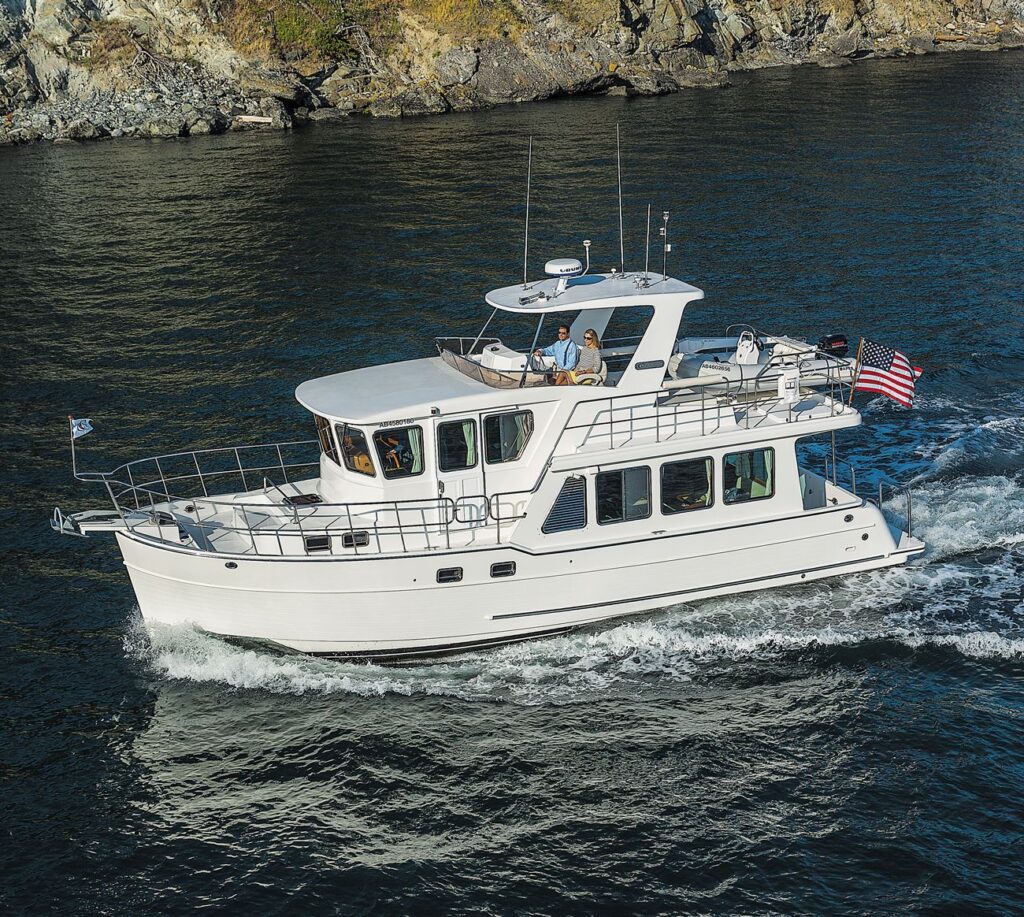At North Pacific Yachts, we know that proper yacht maintenance isn’t just about keeping your vessel looking pristine—it’s about protecting the investment, ensuring peak performance, and maximizing longevity. Each season presents unique challenges, from salt buildup and UV exposure in the summer to freezing temperatures and moisture control in the winter. That’s why we emphasize a proactive approach, aligning maintenance schedules with seasonal changes to prevent small issues from becoming costly repairs. A well-maintained yacht isn’t just more reliable; it also retains its value, ensuring that every voyage is as smooth and enjoyable as the first. Whether it’s hull integrity, mechanical systems, or onboard comfort, we apply the same craftsmanship and attention to detail in maintenance as we do in yacht building.
Spring and summer demand rigorous exterior care, ensuring antifouling coatings are fresh, engines are running efficiently, and onboard systems—from HVAC to electronics—are operating at full capacity. During the off-season, winterization is critical, whether your yacht remains in the water or is hauled out for dry storage. We prioritize proper fuel stabilization, battery management, and moisture control to safeguard against corrosion and degradation. At every stage, meticulous upkeep extends beyond routine checklists; it requires understanding the specific materials and engineering of each vessel. That’s why owners who work with a dedicated yacht builder like us benefit from tailored maintenance strategies designed around their yacht’s unique specifications. Proper care isn’t just about preventing wear and tear—it’s about preserving the craftsmanship and performance that define a true North Pacific yacht.

Explaining Seasonal Yacht Care
Why Seasonal Maintenance Matters
Regular seasonal maintenance is crucial for preserving the integrity and performance of your yacht. Climate variations can significantly impact various yacht components. For instance, temperature fluctuations may cause materials to expand and contract, leading to potential structural issues. Humidity and salt exposure can accelerate corrosion on metal parts. Neglecting these seasonal upkeep tasks can result in compounded wear and tear, leading to more extensive and costly repairs over time. Implementing a preventative maintenance approach allows for the early detection and resolution of potential problems, ensuring the vessel remains in optimal condition and reducing the likelihood of unexpected failures.
The Importance of Manufacturer Guidelines
Our custom yacht designs are tailored to meet specific performance and aesthetic standards, which influence their maintenance requirements. Adhering to the builder’s recommendations is essential for ensuring the longevity and reliability of the vessel. Different materials used in construction, such as fiberglass, wood, or metal, each have unique care needs. For example, wooden components may require regular varnishing to protect against moisture, while metal parts might need routine inspections for corrosion. Following manufacturer guidelines ensures that each material is maintained appropriately, preserving the yacht’s overall integrity.
Spring Yacht Maintenance: Preparing for the High Season
Hull & Exterior Inspections
As the boating season approaches, conducting thorough hull and exterior inspections is vital. Antifouling and bottom cleaning are essential to remove marine growth and prevent hull fouling, which can impede performance. Selecting the appropriate antifouling paint tailored to your yacht’s operating environment enhances protection. Regularly inspecting for cracks, blisters, or oxidation in the gelcoat and paintwork allows for timely polishing, waxing, and addressing minor damages before they escalate.
Mechanical & Systems Checkups
Ensuring the mechanical systems are in top condition is crucial for safe operations. This includes replacing fuel filters, checking for leaks, flushing, and refilling coolant systems, and inspecting propellers and shaft alignment. Electrical systems also require attention; load testing batteries after winter storage, cleaning and tightening connections, and verifying the functionality of shore power and onboard generators are all important steps. Plumbing systems should be flushed to check for contamination, and hoses, pumps, and fittings inspected for leaks. Servicing marine toilets and waste systems ensures proper sanitation onboard.
Safety & Compliance Readiness
Updating navigation charts and software for GPS systems, testing radar, depth sounders, and autopilots, and checking VHF radio connections are essential for safe navigation. Inspecting life rafts, fire extinguishers, flares, bilge pumps, emergency beacons, and ensuring personal flotation devices are in top condition enhances safety preparedness.
Summer Yacht Maintenance: Keeping Performance at Its Peak
Routine Exterior Cleaning & Protection
During the summer months, protecting the yacht from UV rays and saltwater is paramount. Applying marine-grade UV protectants helps shield surfaces, while regular washing and rinsing prevent salt buildup that can lead to corrosion. Maintaining non-skid deck surfaces ensures safety for all onboard.
Deck Hardware & Rigging Inspection
Lubricating winches and moving parts, checking for loose fasteners and fittings, and inspecting cleats, railings, and stanchions are necessary to maintain the integrity of deck hardware. Regular attention to these components prevents wear and ensures reliable performance.
Engine & Mechanical System Monitoring
Mid-season engine servicing, including checking oil levels, fuel system integrity, monitoring engine temperature, and cleaning heat exchangers and raw water strainers, keeps the propulsion system running efficiently. HVAC and refrigeration systems also require recharging, cleaning of air filters and ducts, and inspection of seals to maintain onboard comfort.
Onboard Comfort & Guest Readiness
Protecting teak and wooden surfaces, deep cleaning fabrics and cushions, and preventing mold and mildew buildup contribute to a pleasant onboard experience. Descaling and sanitizing desalination units, inspecting propane and cooking appliances, and ensuring fresh water pumps and filters are operational are essential for guest readiness.

Fall Yacht Maintenance: Post-Summer Assessment
End-of-Season Inspection & Repairs
Identifying Summer Wear and Tear
As the boating season concludes, it’s essential to conduct a thorough assessment of your yacht to identify any wear and tear accumulated over the summer months. Begin by inspecting the hull for impact areas and stress points, looking for signs of cracks, abrasions, or deformations that may have resulted from docking or debris collisions. Evaluating the exhaust systems is also crucial; check for soot buildup, corrosion, or blockages that could impair engine performance. Additionally, assess the functionality of the rudder, steering mechanisms, and trim tabs to ensure responsive handling and maneuverability. Addressing these issues promptly can prevent minor problems from escalating into significant repairs.
Preventing Off-Season Corrosion
To safeguard your yacht during the off-season, it’s vital to implement measures that prevent corrosion, which can compromise structural integrity and aesthetics. Start by thoroughly cleaning all metal fixtures, including railings, cleats, and fasteners, to remove salt residues and contaminants. Applying appropriate corrosion inhibitors to these cleaned surfaces will provide a protective barrier against moisture and oxidation. It’s also important to address potential galvanic corrosion by inspecting and maintaining sacrificial anodes, ensuring they are replaced if significantly eroded. Checking for stray electrical currents that could accelerate corrosion is another critical step in preserving your yacht’s condition during periods of inactivity.
Fuel and Engine System Preparations
Fuel System Stabilization
Proper fuel system management is essential to maintain engine health during extended storage. Adding a high-quality fuel stabilizer to the tank helps prevent fuel degradation and the formation of varnish deposits. After adding the stabilizer, run the engine for a few minutes to ensure the treated fuel circulates throughout the system. Draining water separators and fuel lines is also recommended to remove any accumulated moisture that could cause corrosion or microbial growth. Running the engines at idle for a short period allows the stabilized fuel to permeate the system, providing additional protection.
Winterizing Diesel and Gasoline Engines
Preparing your yacht’s engines for winter storage involves several critical steps to prevent internal corrosion and component degradation. Begin by changing the oil and filters to remove contaminants that could cause damage during inactivity. Fogging the cylinders with a specialized oil spray provides a protective coating on internal surfaces, inhibiting rust formation. Lubricating moving parts, such as throttle linkages and pivot points, ensures they remain functional and free from corrosion. Protecting turbochargers and exhaust manifolds by sealing openings and applying protective coatings further safeguards these components from moisture-related damage.
Winter Yacht Maintenance: Storage and Protection
Winterization Strategies for Different Storage Methods
Haul-Out vs. In-Water Storage
Choosing the appropriate storage method for your yacht during winter is crucial for its preservation. Haul-out storage involves removing the yacht from the water and storing it on land, offering protection from ice damage and allowing for thorough maintenance activities. This method is particularly beneficial in regions prone to freezing temperatures. In-water storage, while keeping the yacht afloat, requires diligent monitoring and the use of de-icing equipment to prevent ice formation around the hull. Each method has its advantages and considerations, and the choice should be based on regional climate conditions and the yacht’s specific requirements.
Prepping for Shrink-Wrapping or Covered Mooring
Protecting your yacht from environmental elements during storage is essential. Shrink-wrapping provides a tight, protective barrier against moisture, debris, and UV exposure, preserving the yacht’s exterior and interior. Before shrink-wrapping, ensure all surfaces are clean and dry to prevent mold growth. Alternatively, covered mooring involves using custom-fit covers or tarpaulins to shield the yacht. It’s important to secure these covers adequately and ensure proper ventilation to prevent condensation buildup, which can lead to mildew and corrosion.
Interior and Electrical Winterization
Preparing the yacht’s interior and electrical systems for winter storage is crucial to maintain their condition. Begin by removing all perishables and installing moisture absorbers to control humidity levels and prevent mold growth. Disconnecting batteries and storing them in a cool, dry place helps maintain their charge and extends their lifespan. Preserving electronics involves removing or covering sensitive equipment and ensuring all devices are turned off to prevent battery drain. Protecting materials such as teak, leather, and fabric from humidity can be achieved by cleaning and treating them with appropriate conditioners and ensuring adequate ventilation within the cabin.
Hull and Bottom Protection During Layup
Propeller and Shaft Maintenance
Maintaining the propeller and shaft during the off-season is essential for ensuring optimal performance upon recommissioning. Applying anti-corrosion spray to exposed metal surfaces provides a protective layer against moisture and oxidation. Removing the propeller allows for thorough inspection and greasing of the shaft, which prevents seizing and corrosion. Checking for bent or damaged blades is also important, as addressing these issues during the layup period ensures the propulsion system operates efficiently when the yacht is returned to service.
Bilge and Drainage System Preparations
Ensuring the bilge and drainage systems are properly prepared for winter storage is vital to prevent water accumulation and potential damage. Verify that bilge pumps are functional and free from debris, and consider adding antifreeze to the bilge to prevent any residual water from freezing. Draining non-essential water systems, such as freshwater tanks and water heaters, reduces the risk of freezing and subsequent damage. Protecting seacocks by closing them and ensuring they are free from water prevents cracking due to ice formation.
Year-Round Best Practices for Optimal Yacht Condition
Proactive Maintenance Planning
Maintaining a comprehensive maintenance log is essential for tracking the condition of your yacht. Record all inspections, servicing schedules, parts replacements, and upgrades to monitor the vessel’s history and plan future maintenance activities effectively. Scheduling regular haul-outs and surveys allows for thorough evaluations of the yacht’s condition and timely addressing of any issues. This proactive approach ensures the vessel remains in optimal condition throughout the year.
Partnering with Professionals for Expert Care
While some maintenance tasks can be performed by the owner, certain procedures require specialized knowledge and equipment. Determining when to undertake DIY maintenance versus hiring a specialist is crucial for the yacht’s longevity. Choosing a reputable yacht maintenance service ensures that complex tasks are handled correctly. Collaborating with our yacht-building team provides the advantage of expert care tailored to the specific needs of your vessel, ensuring it remains seaworthy and well-maintained.

Contact Us
At North Pacific Yachts, we’re here to make your journey to owning the perfect yacht seamless and enjoyable. Whether you’re looking for expert guidance on model specifications, insights into custom build options, or simply need a few questions answered, our team is ready to assist. With years of experience in yacht building, we’re dedicated to understanding your unique vision and helping you navigate the entire process with ease. Reach out to us by email at info@northpacificyachts.com for personalized responses to all your inquiries.
If you’d prefer a conversation, we invite you to give us a call at 1-877-564-9989. Speaking directly with our experienced team can provide immediate answers and professional insights into everything from specific build features to delivery timelines. At North Pacific Yachts, your satisfaction is our top priority, and we’re here to ensure you’re confident and informed at every step of your yacht ownership journey.
See our models here:
Related Posts
The Ultimate Guide to Yacht Engine Maintenance
Yacht Hull Care: Cleaning, Painting, and Preventing Damage


